386 Search Results for complex communication
October 5, 2013
by Carole Zangari -
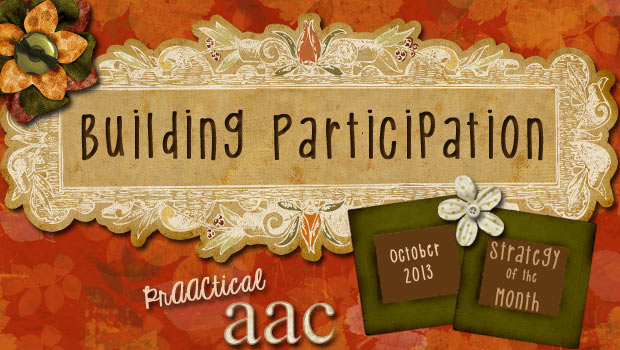
Do you know any of our friends? Jenna can use a talking switch with only a little bit of support. But at calendar time, no one thinks of asking her a question. Hao knows almost two dozen signs and can use a communication wallet with non-signers. But at social gatherings, he’s mostly off to the side playing a game on his iPhone. Isaac uses his SGD capably and can create grammatically correct sentences that include noun phrases and conjunctions. But in Chemistry, his lab group conducts their experiments and writes up the lab report without his contributions. Sienna is able to choose between preferred and non-preferred items in a field of three and is learning to do so in a field of four. But the only time she gets to make a choice is at mealtimes. Like many of you, we put in countless hours helping children and adults who... [Read More...]
September 26, 2013
by Robin Parker -
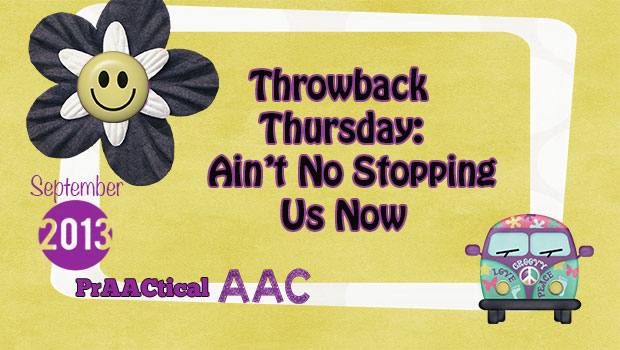
(updated/original version published on October 20, 2012) Sometimes saying ‘no’ to the demands of the day actually helps us rejuvenate and allows us to be more productive. Saying ‘no to false information helps us to advocate for ourselves. The ‘no’ topic seems to be trending now. There have been quite a few blog posts and comments about the issue (Just Say No, How and When to Give Your Students A Break). We are so glad that this topic is getting more focus. Of course everyone agrees that ALL people have the right to say ‘no’. But it is not always so simple. There are many types of ‘no’. There is the outright ‘no’, the ‘no’ to more work, the ‘no’ for disagreement, the ultra important ‘NO’ to unwanted touching, and many more. And depending upon how you say ‘no’ is the difference between it being accepted or… NOT. The issue... [Read More...]
September 12, 2013
by Robin Parker -
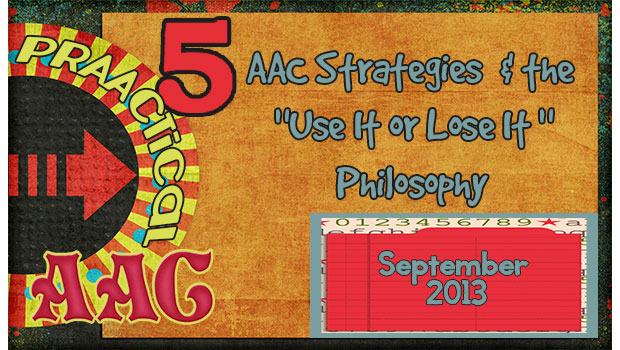
School has begun for almost everyone. Some classes have been in session for a while and routines have been formed, learning is taking place, behaviors have settled down. Now comes what can seem like the hard part: Keeping up with and expanding the strategies that helped students become successful. Instead of trying to fade AAC displays/devices and visual supports, stick with the basics and expand how they can be used. Because if you don’t use it, you may lose it. So: Keep up with: Visual Schedules– monthly, daily, and mini. Even if students know the schedule, continue to use it. Most of us would not like ‘losing’ our day planner or ‘to do’ lists even though we know our schedules. Aided Language Input First- Then Visual Support Visual Boundaries Access to a AAC Display/Device– And the display or device is with the student All the time, everywhere, charged, working, and... [Read More...]
September 9, 2013
by Robin Parker -
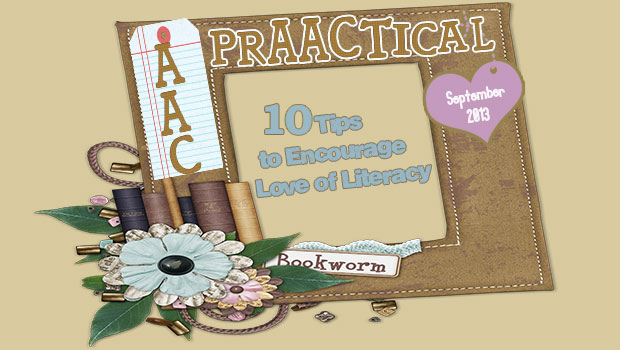
Reading and writing are modalities of language (just like listening & talking). The more we integrate literacy into language learning the more opportunities for prAACtice and learning. Think of all the ways to prAACtice core words with reading and writing (e.g., “read again”, “write about that”, “that is good”, “He was bad”, “tell me more”, “I know”, etc…). With this in mind, we love encouraging a love of literacy for ALL of our students. Here are some top tips we have learned from the most reluctant reader/writers, to beginning reader/writers, to even the more proficient readers/writers. It is such a great pleasure to watch students begin to love literacy as much as we do. Use high interest books– Find books with super high interest pictures and/or text. For some learners, it helps to create your own books with personal interest photos and/or topics. One (very) reluctant reader we know, loved... [Read More...]
September 7, 2013
by Carole Zangari -
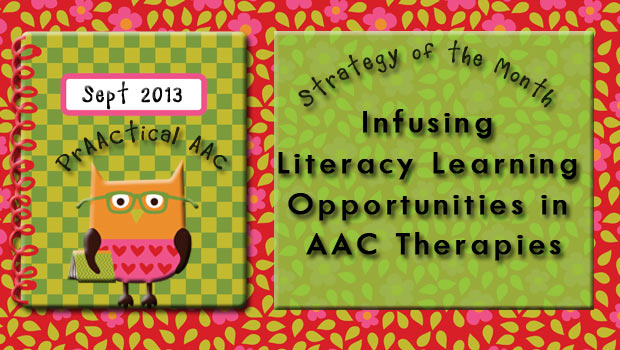
Most of our conversations with SLPs about teaching literacy to individuals with AAC needs revolve around the ‘How’s.” “How can I possibly teach reading and writing? I don’t have enough time with her to teach language and communication!” “How am I going to teach reading to someone who can’t sound out words? Or writing to someone who can barely use a pencil or keyboard?” In general, SLPs WANT to teach literacy skills. They understand the importance of this skill set and how it can level the playing field for people with communication difficulties. They know that reading and writing are inherently linked to speaking and listening. They know that literacy is a powerful key that unlocks many, many doors. And yet, getting from there to the point of actually teaching clients with AAC needs to read and write is not something we do enough of. This month, we’ll look at ways... [Read More...]
August 29, 2013
by Carole Zangari -
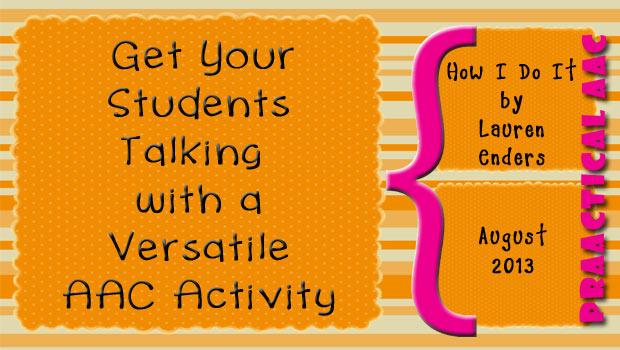
We are so excited to start off the new school year with a wonderfully prAACtical post by Lauren Enders. Lauren’s “How I Do It” posts have been very popular and this one is no different. Today, she shares ways to incorporate key AAC principles in engaging intervention activities and models that with high school students. :::::::::::::::::::::::::::::::::::::::::::::::::::::::::::::::::::::::::::::::::::::::::::::::::::::::::::::::::::::::::::::::::: LEARNING TARGETS (Samples: can be changed to meet student goals) Using core vocabulary, the student will: control the actions of others (beginning with core words like “more”, “stop”, “go”, “again”, and “different”) express his or her opinions through commenting (beginning with core words such as “like”, “don’t like”, “good”, “bad”, and “silly”) TARGET POPULATION: all ages (I have used variations of this activity successfully with students from age 3 through age 21.) TYPE OF AAC: ALL types!! What’s crucial here is the availability of core vocabulary, not the system used. Systems used can vary from... [Read More...]
July 12, 2013
by Carole Zangari -
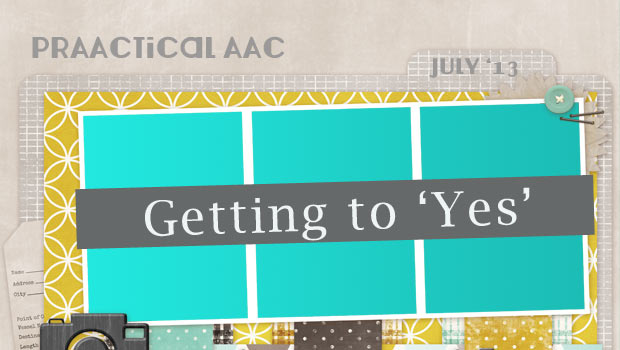
We wanted to be sure that none of our prAACtical friends missed this series of great posts by Kate Ahern of Ahern TEC (Technology, Education, and Consulting). Kate’s content is informed by her direct instruction with students, but also by her experience in consulting with families and educational teams, teaching workshops, and presenting at conferences. Her popular blog, Teaching Learners with Multiple Special Needs, is one of our ‘Go – To’ sites for solid content about technology, instruction, and communication for people with significant special needs. We loved the series that Kate did on the concept of teaching yes/no. It explores the complexity of yes/no and provides information on the various communicative functions that are served. The Yes/No Series Part 1 Part 2 Part 3 Part 4 Part 5 Part 6 Hope you take a few minutes to explore these posts. There is great information for AAC newbies and seasoned... [Read More...]
June 20, 2013
by Carole Zangari -
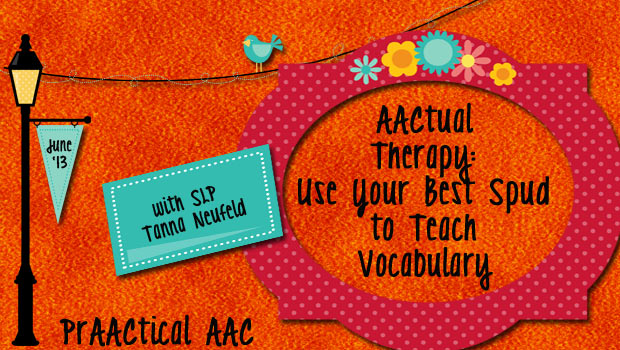
AACtual Therapist Tanna Neufeld comes through again, putting a prAACtical touch on an activity we all know and love. Tanna has generously shared both her ideas and the communication boards that she uses for this activity. You can download them in our eToolBox or go to the links at the end of this post. Tanna has great intervention tips (love her 80/20 idea!) that are prAACtical and effective for keeping kids engaged and learning. Mr. Potato Head is one of my favorite therapy tools for working with all kids, but especially beginning communicators. This awesome spud is not only a versatile toy-ripe for building, pretending, and interacting-but also a great tool for modeling vocabulary. For those little ones that you can keep engaged beyond the putting in and out of the building stage (tap into that good old fashioned, therapeutic use of self!), this toy really goes the distance. I... [Read More...]
June 17, 2013
by Carole Zangari -
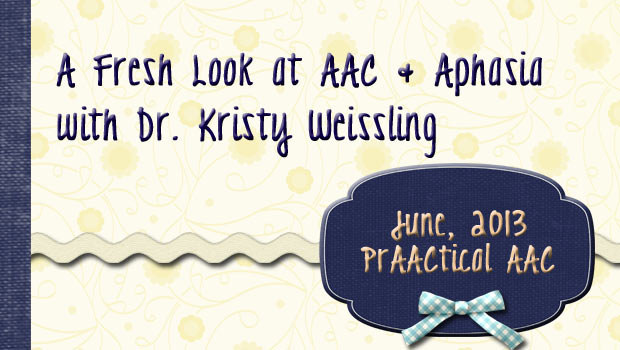
We’re so pleased to be able to share the thoughts of our friend and colleague, Dr. Kristy Weissling, on providing AAC supports to people with aphasia. She received her professional doctorate from Nova Southeastern University and is currently an Assistant Professor of Practice and clinical supervisor at the Barkley Speech-Language and Hearing Clinic at the University of Nebraska-Lincoln. Her research and teaching interests include, aphasia, cognitive communication impairments, and AAC. She participates in implementation of a portion of the RERC grant project at the University of Nebraska-Lincoln. She has been an instructor in aphasia and cognitive linguistic impairments for 15 years and teaches in both online and live formats. Her clinical load includes individual and group treatment of individuals with aphasia, traumatic brain injury, and early cognitive decline. In this post, Kristy reflects on three articles that have shaped her clinical services and teaching. :::::::::::::::::::::::::::::::::: I have been working with people who... [Read More...]
May 23, 2013
by Carole Zangari -
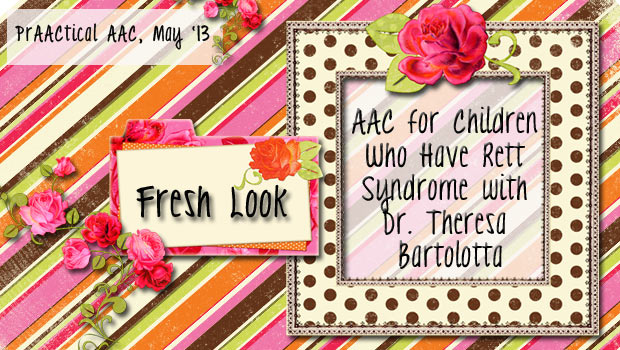
In our SLP training programs, few of us learned about Rett Syndrome or how to provide services to children with that disorder. We’re so pleased to have a guest post on AAC services for children with Rett by Dr. Theresa Bartolotta, Director of Assessment in the Office of the Provost, and Associate Professor in the Department of Speech-Language Pathology, at Seton Hall University, in South Orange, New Jersey. An SLP with over 30 years of clinical experience, she specializes in communication disorders in children with significant disabilities with a special interest in autism and Rett syndrome. Our field is still learning about Rett syndrome and we are still discovering new things about the range of skills and abilities present in the children who have it. In this post, Dr. Bartolotta gives us some background about the syndrome and discusses implications for treatment. I am thrilled to have this opportunity to post... [Read More...]









